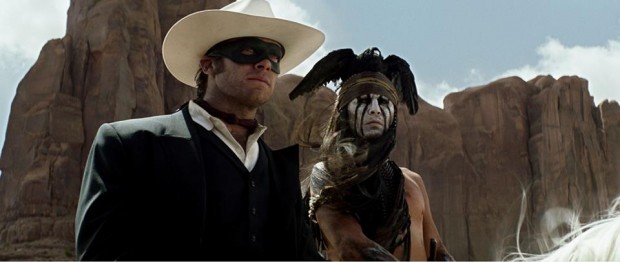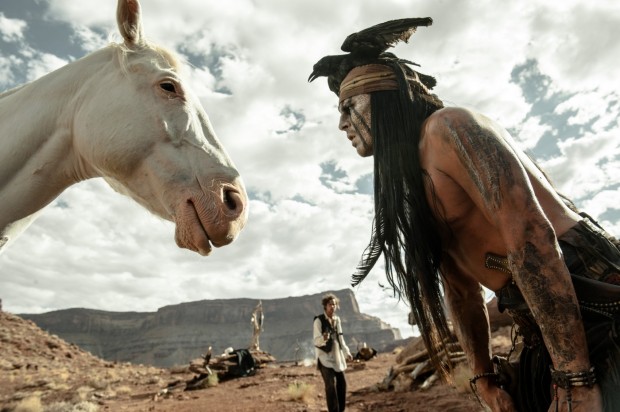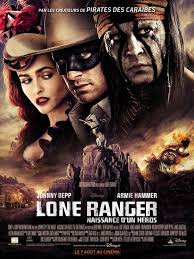Is it any surprise that Gore Verbinski’s The Lone Ranger doesn’t really work? The titular lawman and his precocious white steed Silver, along with Native American pal Tonto, are icons from the golden age of pulp but this thoroughly modern movie pretends to be embarrassed by them.
Hollywood has long had this kind of passive-aggressive relationship with classic pop culture entities, coveting their revered status in the heart of the consumer but balking at their antiquated methods and values. Earlier this summer we saw the Man of Steel reduced from upright to somber and now here’s John Reid, getting about the same treatment his great nephew Britt received in 2011’s The Green Hornet; he’s transformed from a defender of justice to a bumbling ninny who’s got to learn heroism from his long-suffering ‘sidekick.’ With this reluctance to embrace the character, the movie feels like a schizophrenic sideshow that only shines when Verbinski and his team stop fussing with the Ranger’s image.
Although not remotely in the same pitiful camp as Wild Wild West or Jonah Hex, The Lone Ranger is far from the boisterous, colorful adventure that marked jovial throwbacks like The Mask of Zorro or Pirates of the Caribbean: Curse of the Black Pearl. Conflicted and erratic in tone, this Ranger has many of the same problems that afflicted the Caribbean sequels — too dark, too bloated — without any of those films’ sense of rampant, wild creativity. Depp’s Tonto, reconfigured from proud Comanche to damaged, vengeful tracker constantly feeding the kitschy dead crow on his head, is presented as the story’s magnetic center. There’s even an unconvincing and bizarre book-ending sequence that features an aged Depp, ala Little Big Man, telling a little boy the Ranger’s tale inside a Wild West museum in 1930’s New York.

The problem is that this Tonto, like the film he’s inhabiting, is an incongruous lump of conflicting emotions and inspirations; while most of the character is pitched at campy, broad cartoonish mysticism, there are certain compartments of his soul that internalize the long-echoing ache of the Native American plight during westward expansion and after. Instead of this latter element being commendable or poignant, it just feels off; an unfortunate after-taste to a character who is all graphic novel exaggeration and box-office swagger. He’s Comanche Jack Sparrow-Hawk, for all intents and purposes, and although Depp puts on his best outsider performance, there’s no getting away from the fact he creates an imbalance the film never recovers from.
Of course, if we had a John Reid whom we cared about and could rally behind, Depp’s Tonto would seem so disastrously off-center. Armie Hammer, whos has the looks and the matter-of-fact charisma necessary for ‘dashing’, is never really allowed to blossom in that way, often relegated to being a goofball who’s trying at hero. In his performance are callbacks to another tv gunslinger, Bruce Campbell’s Brisco County Jr., but the comparison point does Ranger no favors because Campbell and his writers made Brisco simultaneously buffoonish, brave and bold, resulting in a character that honored as much Western mainstays as he spoofed them. This Reid is the less competent little brother of an imposing ranger, who’s married John’s sweetheart and had a child with her (actually, the script hints elsewhere on this point) while the younger man was off at college studying the justice system.
A deformed rattlesnake of a man, Butch Cavendish (William Fichtner) ambushes the rangers, murders John’s brothers and, in a not-so-Disney-ish gesture, rips out his beating heart and eats it in front of him, while leaving John for dead alongside his slaughtered friends. He’s rescued by Tonto, and given the mask, fed a line about returning from the dead to achieve justice and finding a spiritual guardian in the form of a majestic alabaster stallion.

As Reid and Tonto backtrack along a convoluted plot involving silver mines, the burgeoning railway, framed Comanches and Tom Wilkinson’s scheming railroad manager, it becomes apparent that the supernatural touches aren’t channeling some tall tale mythos, but are actually the delusions of Tonto’s broken psyche. It’s an idea that sounds neat on paper, but so little is done with it that it feels like one more distraction. Verbinski also applies a leaden hand that dulls the logic. Why would Cavendish physically eat the hearts of his enemies if he’s only the Wendigo in Tonto’s carefully constructed dreamworld? I suspect the bookends that remind us Tonto is narrating are intended to smooth-out these inconsistencies.
The movie looks great and I was heartened to see grand, majestic vistas instead of computer-generated landscapes. The costuming and design and visual effects, like Verbinksi’s other big-budget endeavors, are flawless and handsomely integrated. At a performance level, it’s mostly what you would expect, with simply too many characters wedged into the corners of the story. Helena Bonham Carter has a nifty ivory leg, but not much to actually do and she’s just out-of-place from her very first scene. There are even moments where it threatens to work as the socially-minded revisionist Western it clearly wants to be, but the juices start flowing, we are wound back in for something commercial and creatively pedestrian.
As the film started to lurch towards that two-hour mark, I was mostly done with The Lone Ranger. Then a curious thing happens; Hammer appears on Silver, the William Tell Overture is soaring on the soundtrack, and Verbinski delivers a delirious final action sequence on dual trains speeding next to each other, all the characters engaged in a skirmish that feels like Buster Keaton goes Gunsmoke! At this point, the movie transforms from timid to full-bodied and rousing, and if there was any doubt that a Lone Ranger movie could make the magic happen, this scene should have dispelled worried execs. In the end, it’s too little, too late, though it left me on a positive note walking out. Alas, this is a review of the entire Lone Ranger movie, and I’ve got to say it’s better to save your money on this one.
The Lone Ranger opens in wide release on Wednesday, July 3rd.

